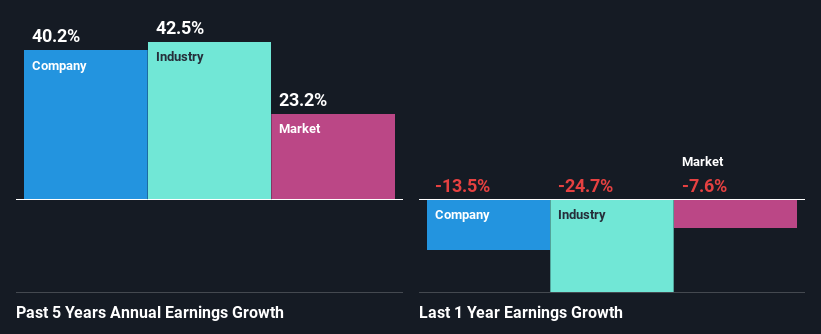Cardinal Energy Ltd.'s (TSE:CJ) Stock Has Been Sliding But Fundamentals Look Strong: Is The Market Wrong?
Cardinal Energy (TSE:CJ) has had a rough month with its share price down 7.1%. But if you pay close attention, you might gather that its strong financials could mean that the stock could potentially see an increase in value in the long-term, given how markets usually reward companies with good financial health. In this article, we decided to focus on Cardinal Energy's ROE.
Return on equity or ROE is a key measure used to assess how efficiently a company's management is utilizing the company's capital. Put another way, it reveals the company's success at turning shareholder investments into profits.
View our latest analysis for Cardinal Energy
How Do You Calculate Return On Equity?
Return on equity can be calculated by using the formula:
Return on Equity = Net Profit (from continuing operations) ÷ Shareholders' Equity
So, based on the above formula, the ROE for Cardinal Energy is:
21% = CA$197m ÷ CA$929m (Based on the trailing twelve months to September 2023).
The 'return' is the profit over the last twelve months. So, this means that for every CA$1 of its shareholder's investments, the company generates a profit of CA$0.21.
Why Is ROE Important For Earnings Growth?
Thus far, we have learned that ROE measures how efficiently a company is generating its profits. We now need to evaluate how much profit the company reinvests or "retains" for future growth which then gives us an idea about the growth potential of the company. Generally speaking, other things being equal, firms with a high return on equity and profit retention, have a higher growth rate than firms that don’t share these attributes.
A Side By Side comparison of Cardinal Energy's Earnings Growth And 21% ROE
At first glance, Cardinal Energy seems to have a decent ROE. Especially when compared to the industry average of 17% the company's ROE looks pretty impressive. This probably laid the ground for Cardinal Energy's significant 40% net income growth seen over the past five years. We reckon that there could also be other factors at play here. Such as - high earnings retention or an efficient management in place.
We then performed a comparison between Cardinal Energy's net income growth with the industry, which revealed that the company's growth is similar to the average industry growth of 42% in the same 5-year period.
Earnings growth is an important metric to consider when valuing a stock. The investor should try to establish if the expected growth or decline in earnings, whichever the case may be, is priced in. This then helps them determine if the stock is placed for a bright or bleak future. What is CJ worth today? The intrinsic value infographic in our free research report helps visualize whether CJ is currently mispriced by the market.
Is Cardinal Energy Making Efficient Use Of Its Profits?
Cardinal Energy's three-year median payout ratio to shareholders is 1.7%, which is quite low. This implies that the company is retaining 98% of its profits. So it looks like Cardinal Energy is reinvesting profits heavily to grow its business, which shows in its earnings growth.
Additionally, Cardinal Energy has paid dividends over a period of at least ten years which means that the company is pretty serious about sharing its profits with shareholders. Our latest analyst data shows that the future payout ratio of the company is expected to rise to 107% over the next three years. Consequently, the higher expected payout ratio explains the decline in the company's expected ROE (to 12%) over the same period.
Conclusion
In total, we are pretty happy with Cardinal Energy's performance. In particular, it's great to see that the company is investing heavily into its business and along with a high rate of return, that has resulted in a sizeable growth in its earnings. If the company continues to grow its earnings the way it has, that could have a positive impact on its share price given how earnings per share influence long-term share prices. Let's not forget, business risk is also one of the factors that affects the price of the stock. So this is also an important area that investors need to pay attention to before making a decision on any business. Our risks dashboard will have the 1 risk we have identified for Cardinal Energy.
Have feedback on this article? Concerned about the content? Get in touch with us directly. Alternatively, email editorial-team (at) simplywallst.com.
This article by Simply Wall St is general in nature. We provide commentary based on historical data and analyst forecasts only using an unbiased methodology and our articles are not intended to be financial advice. It does not constitute a recommendation to buy or sell any stock, and does not take account of your objectives, or your financial situation. We aim to bring you long-term focused analysis driven by fundamental data. Note that our analysis may not factor in the latest price-sensitive company announcements or qualitative material. Simply Wall St has no position in any stocks mentioned.

